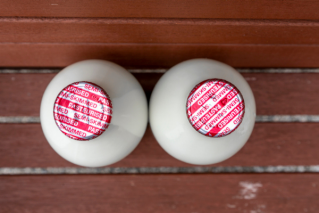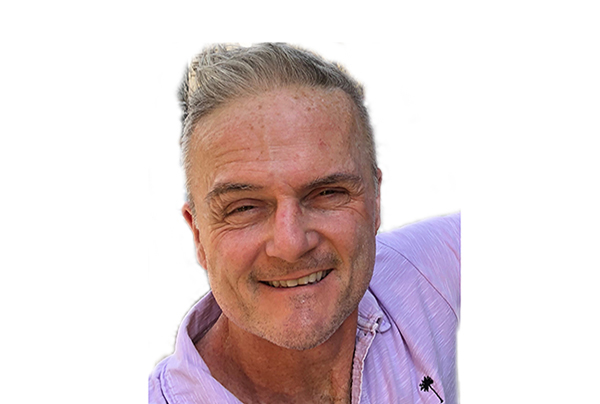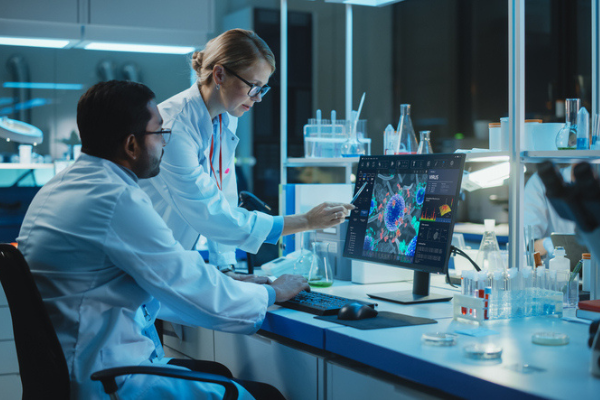
Is any country doing chemical safety awareness better than the U.S.? If so, what are they doing to achieve this superiority?
The British Health and Safety Executive (HSE, the British equivalent of US OSHA) has had consistent political support from Parliament. Over decades, the HSE has fostered a nationwide attitude of safety awareness. This is reflected in an overall injury rate about ½ of that in the USA. British employers, of all sizes, know they are expected to meet well-defined and well-supported performance standards.
Based on your experience, what letter grade would you give the following in terms of their overall safety awareness programs, where A is best and F is worst: Industry, Academia and Government. Please briefly explain your grades.
Sector | Grade |
Industry - research | B+ |
Industry - production | C |
Academia – graduate-degree granting institutions | B |
Academia – undergraduate-degree only institutions | C- |
Government National Labs | A- |
Industry generally does a good job with research-level safety. The global-scale facilities, particularly in pharma, electronics/semiconductors and materials have strong safety cultures. As you look further afield, however, safety performance falls off. There is room for improvement.
The production industry is in serious need of infrastructure upgrade and the application of the concept of process safety across all facilities, not just those currently covered by the Process Safety Standard. The production industry is myopic, and this hinders improvements based on lessons learned. There is much room for improvement globally.
Safety improvements in Academia at all levels is hampered by the concept of academic freedom. Allowing each professor to act as a small business entity with no reporting to their actual employer is a substantive flaw.
UCLA, Texas Tech and Yale got the attention of administrators in many graduate-degrees granting institutions. In the decade since these incidents, administrators and EHS staff have created a fertile environment for safety culture improvement, and it shows. There is much room for improvement, particularly in the area of metrics to quantify safety practices and lead improvement.
Smaller schools, particularly the undergraduate-only campuses, have a very spotty safety performance record. If the campus has a strong safety champion, the culture flourishes. If not, then the lack of administrative leadership, usually expressed by the lack of funds, leaves the well-being of faculty, staff and students in the hands of blind luck.
For a variety of political reasons, all the National Labs have elevated safety performance to the same level as productivity. The Labs provide strong support for taking the time to carry out the work safely. And, the labs share their success and failures with the chemical enterprise. While there is improvement to be made, the National Labs stand as models for everyone else.
If you were the Chemistry Department Chair at a leading academic institution in the U.S., how would you go about making students more familiar with alternative careers?
Making students aware of alternative careers in chemistry requires exposing the students to the idea and to successful chemists pursuing alternative careers. These can be accomplished in the same way we expose students to traditional career paths. The topic is discussed, and speakers are invited to the department to talk about their accomplishments. As a Department Chair, I would identify department graduates who have pursued careers in law, forensics, journalism, and others and make certain that 1 or 2 of them present department seminars annually AND have a chance to meet with students.
As students prepare to attend professional meetings (ACS National or Regional) urge them to seek out alternative-career topics or individuals with whom to interact.
What’s the best career decision you ever made? What prompted it? What would have happened had you not made it?
I decided I wanted to be a “scientist” on 4 October 1957, immediately after Sputnik was launched. It took four more years for me to decide that “scientist” really meant “chemist”. If those two decisions had not been made, I am sure I would have wound up in a technical field, but I have no idea what or where. In high school, science was cool and in college, physical chemistry became the most interesting, and challenging, discipline in chemistry. This all led to a PhD in bioenergetics and thermodynamics.
Please comment on something you got wrong in your career. What was it? And what did you learn from it?
I have been fortunate in that each career disaster opened an opportunity for growth. The singular event that ultimately led me to chemical safety was an explosion in an inorganic chemistry lab while in grad school. I was at my desk, studying for an up-coming exam, when a professor was injured by a run-away reaction in his fume hood across the hall from me. The force of the blast rammed the doors to his lab shut and I was so panicked that I forgot there was another entrance around the corner. He recovered fully from his injuries. Years later, this event helped me accept faculty ancillary duties for department safety and then leave academia for my career in chemical safety consulting.
You have been an ACS member for over 50 years (thank you, by the way)! What kept you as a member all those years?
I joined ACS as an F&M student at the urging of the chemistry faculty. ACS was my earliest exposure to a professional discipline society. Over my career, I was affiliated with the Federation of Societies of Experimental Biology, the Biophysical Society, the Calorimetry Society, and the American Institute of Chemical Engineers. ACS remained my professional home and has always provide me with the network (contacts) to pursue my interests in chemistry. I am proud to be a chemist and proud to be an ACS member.
What motivated J.T. Baker to develop its Chemical Safety Workshop, which you have said was a watershed event in the area of safety awareness in the U.S. chemical industry.
In the late 1970’s, Bill Norton, a J.T. Baker sales development executive, convinced the company that a chemical safety workshop would be an effective marketing tool. Bill recruited Warren Kingsley and Eileen Segal to develop and run the workshop. Warren and Eileen were active members of the early days of CHAS.
The Baker Office of Training services also developed the hallmark Saf-T-Data labeling system, a RCRA workshop and a chemical spill response workshop. Several of the Baker instructors are still CHAS members. This organized training effort ultimately led the way to wide-spread and mandatory chemical handling training.
What advice do you have for chemists with an entrepreneurial mindset?
I look back on the advice I received about 1980 – 1982. First, create a financial situation that allows you and your family not to worry about income for at least two years. Then, accept the risk of failure and pursue your dream. If it works, great. If not, you know you gave it your all, so pick up and do it again.
For those with a Ph.D., you have demonstrated that you can conceive a good idea, develop and implement a plan to address it, and successfully package the results in a marketable manner (your dissertation). Gain strength from this success and apply what you learned to your entrepreneurial goal.
What do you know more about at this point in your career: Chemistry, or running a small business?
CRISPR, MOFs, tabletop mass spectroscopy and more have left me behind. As much as I love chemistry, I realize that I have only cursory knowledge of many areas of the discipline. After devoting 32 years to running small businesses and doing business management consulting, I sadly admit that I know more about business than chemistry.
You are a very talented photographer, with a number of striking underwater photos to your credit. Walk us through your safety protocol as you prepare to take underwater images.
I assume you are asking about life safety and not about the protection of the cameras I take in the water. SCUBA is an equipment-centric activity. The safety of my next dive starts with the cleaning and maintenance of my gear when I get home from a dive trip. Prior to leaving for a trip, regulators, straps, and all life safety equipment are checked. Prior to entering the water, all gear is function checked using a protocol that has become a habit after about 10,000 lifetime dives.
Immediately upon entering the water, I do a “life safety” check of all gauges and the location of every piece of equipment hung on my body. Then, even as I concentrate on photography, a portion of my brain focusses on life safety. My habits demand that I always know my remaining air supply to within ±100 psi (±10 bar) and my remaining no decompression bottom time to with five minutes.
As age has taken a toll on my body, I have reduced my maximum planned depth significantly. Most of my warm water diving is less than 20 meters and lasts for 60 – 80 minutes. SCUBA, as with any physical activity, requires respecting the challenges presented and always preparing thoroughly.
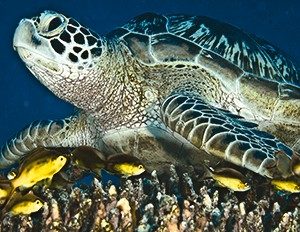
Is there a particular image you are most proud of capturing (underwater or above water, your choice)? Which one, and what’s the back story on it?
There are 52,000 images in my Adobe Lightroom catalog. My favorite changes frequently. Last week, my wife pointed to a turtle image on the wall in our home and asked me if I could ever top it. [Editor’s Note: The turtle image appears nearby].
It was taken in the water around Apo Island in the Philippines. Apo was a challenge. No running water. No flush toilets. Electricity for about two hours each night (barely enough time to charge batteries.) A single small restaurant at the dive resort. Our room was above the dive shop, accessible via a narrow, twisting rock stair way. But the diving was awesome. The turtle sitting on a coral head and surrounded by small fish expresses my love of the underwater world.
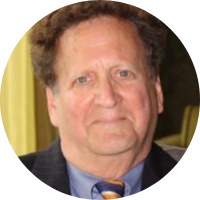
Dr. Langerman is a chemist, earning a Ph.D. in biochemical thermodynamics at Northwestern University. He received a B.S. in Chemistry from Franklin & Marshall College in Lancaster, Pennsylvania. Following a NIH Post-Doctoral year at Yale, he joined the faculty of the Departments of Biochemistry and Pharmacology at Tufts University Medical School in 1970. In 1975, he went west and joined the Chemistry Department of Utah State University. At both Tufts and USU, he assumed responsibility for departmental safety programs. In 1979, Dr. Langerman learned of RCRA, and this started him on his career as a consultant.
Dr. Langerman established his first consulting company, Chemical Safety Associates, in 1980, in conjunction with other members of the USU faculty. He headed this firm until 1997, when he sold his interests in MSDS production and set up his current consulting firm, Advanced Chemical Safety.
Dr. Langerman’ s professional interests are in the prevention of chemical incidents and injuries. His professional time is spent consulting on chemical safety & security, and regulatory issues. He served as the Chair of the Division of Chemical Health and Safety of the American Chemical Society in 2004 and also, in 2004 and 2013, received the Tillsman-Skolnick Award for contributions to the field of chemical health and safety through the ACS from the Division. He is currently the Treasurer of the Division.
Dr. Langerman is an avid SCUBA diver and photographer.
This article has been edited for length and clarity. The opinions expressed in this article are the author's own and do not necessarily reflect the view of their employer or the American Chemical Society.
Copyright 2019 American Chemical Society (All Rights Reserved)


